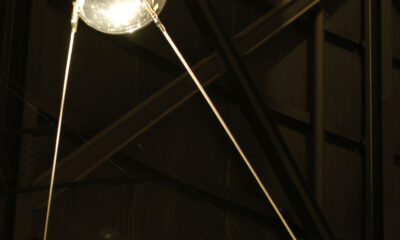Let's Talk
Starship prepares to launch
Starship, SpaceX’ heavy-lift rocket, has its first integrated test flight today (April 17). The risks, and rewards, are equally great.
Today, Starship – not an actual interstellar vessel, but the most powerful rocket ship ever built – has an integrated test flight. The Federal Aviation Administration granted approval, and the Space Exploration Company (SpaceX) announced a definite launch attempt. This will result either in the greatest catastrophe in the history of space flight, or a permanent change in the space launch game. SpaceX, the builder of Starship, has its reputation on the line as never before, considering a nearly unblemished record of success stretching for several years. Only a very stubborn, very visionary man would take the risk Elon Musk, owner of SpaceX, is taking. To understand why, one must review some history, both fact and fiction.
Fictional precursors to Starship
The obvious fictional vessels that some call “starships” in the generic sense are:
- Space Cruiser C57D from Forbidden Planet (dir. F.M. Wilcox, with Leslie Nielsen, Anne Francis, and Walter Pidgeon; MGM, 1956), and
- A plethora of ships all named USS Enterprise in a television and motion-picture franchise called Star Trek.
The politics of the latter franchise (including a real-life political candidate making a more-than-cameo appearance) need not concern us here. (Except that the most famous actress from the original series clearly broke new ground that needed breaking.) How Star Trek (like Forbidden Planet before it) played fast and loose with basic physics concerns us more. Both franchises assumed faster-than-light travel and total gravity manipulation (enabling a crew to walk on a flat deck). What carried both franchises were the believability of the characters. (Though in this regard, Forbidden Planet, which assumed that a ship of a space-born navy would have enlisted ratings, was more realistic. Star Trek assumes that everyone aboard a “starship” is the equivalent of a qualified astronaut, therefore an officer. Real officers and enlisted in real navies understand intuitively that this cannot hold.)
Stanley Kubrik breaks new ground.
Then came 2001: A Space Odyssey (dir. Stanley Kubrick; with Kier Dullea, Gary Lockwood, Douglas Rain (voice) and William Sylvester; MGM, 1968). Kubrick broke the mold, with the first realistic portrait of space travel, respecting the limitations of physics. Weightlessness would be a thing; flight attendants wore full hair-encasing bonnets and “grip shoes” to walk the decks. Space was silent, unless you were inside a ship or wore an EVA suit. To achieve the equivalent of gravity, you had to be within a centrifuge. This could be either the entire structure (like Space Station Five, shown with one section under construction) or a structure within the structure (like the working, eating and sleeping “deck” aboard USS Discovery XD-1). Up-down orientation is purely arbitrary.
To be sure, Kubrik did “goof.” Some of his “goofs” one can forgive – after all, neither he nor the owners of certain brands he placed (Pan Am, Howard Johnson’s, Ma Bell, and Hilton) could have predicted that some of their brands would vanish. But he did make two major technical goofs. The Pan Am airliner that docks with Space Station Five looked like a single-stage-to-orbit craft. This would violate the Tsiolkovsky Rocket Equation. Furthermore, Heywood Floyd and his stewardess ride in comfort from hub to wheel in total disregard of the Coriolis forces that would fling them both to one end of the wraparound couch on which they sit (without safety belts!). Less importantly, the landing cockpit of the trans-lunar shuttle does not appear on the model.
Visions of a starship
Nevertheless, Kubrik deserves credit for a realism no one has yet equaled. That aside, at least two space scientists, Robert Duncan Enzmann and G. Harry Stine, envisioned ship designs and even a complete program for interstellar exploration and colonization. Elon Musk might, or might not, be thinking that far ahead. Right now he is trying to get his actual Starship off the ground.
Starship consists of two parts, both reusable – the booster and the “ship.” Each has had at least some independent tests. The booster recently passed the greatest static-fire test in history. Several versions of the “ship” have taken off, and all but one have blown up, in flight or after landing. But one didn’t blow up, and that was enough for Musk to proceed to today’s test.
Elon Musk needs this vessel to support his real ambition: to plant a self-supporting city on Mars. Of course he also plans for this vessel to support itself economically.
Carrying capacity
Starship will be able to carry 100 or 150 metric tons into low Earth orbit. (The old Saturn V managed 140 metric tons). But Musk wants to re-fuel it in flight, so that it could move those 150 metric tons to geostationary Earth orbit – or to trans-lunar or trans-martian injection. The most the Saturn V could manage was 43 metric tons to TLI. That was enough to send a three-man crew to the Moon and back, and gather and return samples. (It would not, contrary to the Peter Hyams film Capricorn One support moving such a payload to TMI.) Starship, with the proposed in-flight refueling, could accomplish feats of which the builders of Saturn V scarcely dreamed. (Apologies to H. G. Wells.)
SpaceX already intends using Starship to lift the next generation of Starlink satellites into orbit. These are simply two heavy for its current workhorse, Falcon 9 – and Falcon Heavy, since it must expend one of its three tandem boosters, would cost too much. No one – yet – has a payload that large. But as soon as one creates a new tool, someone else invents a use even the original inventor never imagined.
Previous experience
Given the successes SpaceX now enjoys with Falcon 9 and Falcon Heavy, many might anticipate today’s launch with complete confidence. Even Elon Musk would not go that far:
Well might he advise caution! Before SpaceX, no one even imagined reusing any part of a rocket ship, even the booster. But boosters are expensive. Apparently Elon tried to buy rockets from RKK Energia, the Russian rocket builder. They basically told him he was out of his league. So he made a decision Charles A. Lindbergh no doubt would recognize: if you can’t buy one, build one! And the first thing Elon Musk recognized, was how incredibly wasteful rocket building is. One does not, as he pointed out, use a commercial airliner or air freighter once, then throw it away! But in space exploitation, one does it all the time. Musk would change that.
As of today, he hasn’t lost a Falcon 9 booster in years. But once he lost them all the time – then one in three – then one in ten – and finally, no more. The problem for him is that people forget about all the boosters he lost before he could make Falcon 9 reliable enough to use it to send astronauts to the International Space Station (or the new Axiom station now under construction).
Project Apollo and its precursors
Still fewer people alive today recall the failures of Projects Vanguard (which had two successes), Mercury, Gemini, and Apollo. Tom Wolfe (The Right Stuff) recalled Mercury’s failures, like the rocket that blew up directly overhead – and the Redstone rocket that literally popped a cork. (In fact that was the Mercury capsule’s Launch Escape System, which at least function as designed, if nothing else did.) Nor do they want to remember the horrific fire that killed three astronauts, two of them veterans, in a rehearsal. (That might be one reason why Elon Musk does not use test pilots in his Starship development program.) Not to mention the one failure that almost cost the lives of three astronauts, but didn’t: Apollo XIII. People prefer instead to remember the successes of these programs, and the astronauts who went up and came back.
But perhaps they should remember a rocket named N1, a project of the old Soviet Union. Had it succeeded, it might have sent even heavier payloads to the moon and brought them back. But it failed – and in spectacular, and deadly fashion. On July 3, 1969, an N1 took off, cleared the launch tower (just barely), then blew up. It was the worst explosion in the history of rocket development, and destroyed the launch complex. Only by a miracle did the Soviets not lose any lives that day. The Soviets would try twice more, then cancel the program. (And thirteen days after that spectacular failure, Apollo XI would launch.)
Starship and the price of failure
SpaceX absolutely cannot afford a failure as catastrophic as N1’s second flight was. That’s even allowing that the failure of N1’s second flight could have been worse! More of the fuel could have detonated, or it could have mixed with the air to form an explosive gel.
That is not likely to happen with engines that burn methane. But an explosion of the booster alone could destroy the entire proving ground – and kill people. To say nothing of the animal habitats that prompted the Sierra Club to beg the FAA to disallow the program. (The recent FAA approval has struck the Sierra Club strangely silent. Are they sulking – or holding their breath? We’ll find out soon enough today! They’ll likely either breathe a sigh of relief – or scream bloody murder.)
The most Starship will accomplish today is to:
- Lift off without blowing up,
- Clear the tower,
- Reach and pass the maximum aerodynamic pressure (Max Q) point, then
- Separate the booster from the “ship.”
The booster must then flip around, light at least some of its engines, stop, reverse trajectory, and fall back into the Gulf of Mexico.
If the “ship” survives to separation, it should have no hazard for the next hour or so. The most hazardous parts of any rocket mission are liftoff and landing – same as for an airplane. So the ship will coast to re-entry, and splashdown off Hawaii.
The rewards
So we wait – for either the worst disaster since the loss of the airship Hindenburg in 1937, or the first step toward changing the rocket launch game forever. One might expect success to overshadow even America’s contentious politics. After all, Apollo VIII did that in December of 1968, and that one event overshadowed everything else that year, including:
- Two political assassinations (Dr. Martin Luther King, Jr. and Sen. Robert F. Kennedy, D-N.Y.),
- Riots in inner cities and college campuses,
- The death of one of the last Presidents to have universal love (Dwight D. Eisenhower),
- A political convention that saw riots and skull-cracking police response, and
- A long and bitter Presidential election that could have ended in another throw to the House of Representatives. (This did not happen.)
Apollo VIII caused all that to pale into insignificance. For SpaceX Starship to do the same, will take more time – if it can happen at all.
About the image
The collage of spacecraft, including Starship, that could reach the moon, is titled Lunar Options. Bill Davis, its creator, has released it into the public domain.
Terry A. Hurlbut has been a student of politics, philosophy, and science for more than 35 years. He is a graduate of Yale College and has served as a physician-level laboratory administrator in a 250-bed community hospital. He also is a serious student of the Bible, is conversant in its two primary original languages, and has followed the creation-science movement closely since 1993.
-

 Civilization3 days ago
Civilization3 days agoDC Pipe Bomb Arrest Raises Questions About Christopher’s Wray’s FBI
-

 Civilization4 days ago
Civilization4 days agoThe Legal Logic Behind U.S. Operations Against Narco-Terrorist Networks
-

 Executive4 days ago
Executive4 days agoNewsom’s ‘National Model’ for Homeless Wracked by Fraud
-

 Executive3 days ago
Executive3 days agoWhen You’re in a Hole, Stop Digging
-

 Education3 days ago
Education3 days agoWaste of the Day: Taxpayers Subsidize Football Coach Severance
-

 Executive2 days ago
Executive2 days agoWaste of the Day: Obamacare Failed Test, Approved Fraudulent Subsidies
-

 Civilization2 days ago
Civilization2 days agoPence Calls on Trump To Fire RFK Jr Over Abortion Drug
-

 Executive4 days ago
Executive4 days agoWaste of the Day: Feds Pay Nonprofits That Sue the Government














